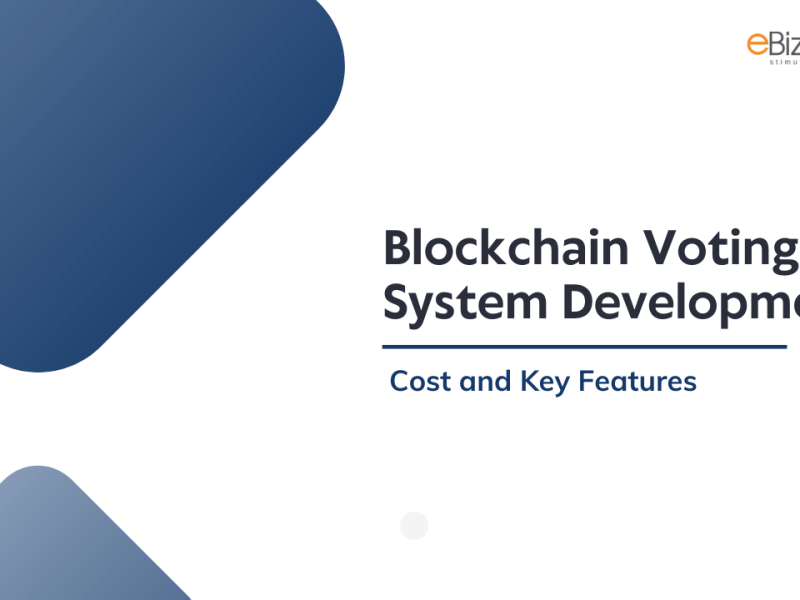It’s become a sort of custom for me. Writing a blog post regarding the impending trends in blockchain software development and the crypto sphere over the next year and more. When I came to this conclusion a year ago, I said, “Always be prepared for the unexpected.” It was also surprising to see the DeFi and NFT markets emerge. However, there is also a growing number of traditional institutions getting into the crypto game, believing that cryptocurrency is here to stay. What may this year bring? In the following 15 trends, we’ll go through this in detail and cryptocurrency app development.

The Following are 15 Trends Set to Rule the Blockchain Market
1. New third and fourth-generation Blockchain solutions
De-accelerated development of new third and fourth-generation solutions targeted at eliminating speed and scalability issues is the first trend we will see. There are third-generation blockchain platforms that use sharing technology to address scaling issues and reduce transaction costs. The distributed application capabilities of blockchain were also improved by these platforms.
There are also fourth-generation blockchains, which are targeted at resolving earlier issues and enabling trust in easy-to-consume methods, facilitating the cryptocurrency app development services, operation, and reconfiguration of corporate networks. This reduced-cost, highly scalable platform is meant to make realistic trade-offs such as understanding that not all transactions are created equal through varying consensus techniques. By using business-oriented interfaces to mask the complexity of blockchain technology, interesting fourth-generation blockchain platforms like In-solar and Aergo are making business networks easier to use.
2. Towards more Blockchain interoperability and standardization.
The development of standards and interoperability options will also speed up
in 2022. These should allow several blockchains to talk to each other. There has been a steady rise in the number of blockchain and distributed ledger networks. To meet their specific needs, most blockchain networks function in isolated ecosystems. As more individuals become aware of the new technology and its capabilities, the need to connect these chains is increasinglyurgent.
Any new technology, including blockchain, must adhere to a set of standards to be successful. For interoperability, trust, and ease of use, the correct standards must be developed at the right moment in a technology’s development. As a result, they aid in its advancement and pave the road for widespread acceptance.
Chains of all shapes and sizes are rising thanks to blockchain’s rapid growth and android app development. Cross-chain technology, an emerging technology that aims to facilitate the transfer of value and information between different blockchain networks, is one example. Interoperability between blockchains is becoming an increasingly heated issue of discussion because of this technology.
3. Blockchain-as-a-service (BaaS) solutions
Many advances in the blockchain environment have led to the rise of BaaS as a popular platform for businesses to use. A third-party cloud-based network management service for enterprises developing blockchain applications will continue to be in high demand in 2022, according to a recent report. Microsoft, Amazon, and R3 are among the most prominent participants in this market.
BaaS makes it possible for its customers to make use of cloud-based solutions to establish hosts run blockchain-related services and react native app development without having to deal with technical challenges or operational overhead or invest in additional infrastructure improvements or lack of skills. BaaS providers assist their customers in concentrating solely on their primary tasks and the blockchain’s capabilities.
4. Great demand for blockchain and crypto skills
Blockchain and crypto talents will be in high demand in 2022. The rising demand for these talents is attributed to the rise of the blockchain business and the increasing use of blockchain in a variety of industries.
Blockchain technology’s promises of cost savings and improved performance for businesses, combined with the burgeoning growth of the crypto markets, are driving up demand for blockchain expertise.Blockchain is predicted to be one of the most sought-after skills in 2021 and beyond, according to a LinkedIn survey. As a result, businesses require blockchain experts who can assist them make the most of blockchain technology to achieve their business goals.
5. Blockchain-IOT-G5 integration
The integration of blockchain with other technologies, such as Big Data and Artificial Intelligence, has become increasingly common this year. Corporate interest in blockchain for IoT (Internet of Things) applications is also on the rise.
Since the recent introduction of the 5G network, the Internet of Things (IoT) market has grown significantly, and this growth is likely to continue throughout the next decade. As a result of this fragmented ecosystem, 5G IoT’s predicted growth potential is now constrained.
Several 5G IoT challenges could be solved with blockchain technology. Due to the automatically encrypted and immutable nature of blockchain, it may be able to help solve many of the security and scalability issues we face today.During the year 2022, we can expect to hear more about pilot projects and early use cases.
6. Blockchain and the Metaverse
This year’s top blockchain trend is the use of blockchain in Metaverse. The Metaverse is Facebook’s new virtual world, where new technologies like blockchain, augmented reality, virtual reality, etc. will be used to create immersive experiences.The Metaverse would be incomplete without blockchain technology since everything would be stored in a single network.
As a result of blockchain, there will be a new generation of social networks that might be even more powerful and superior than the current social networks, such as Facebook and Instagram, which have been synonymous with the term social media.
In 2022, blockchain is expected to run numerous platforms on the Metaverse with NFTs and cryptocurrencies. The new digital economy will be powered by digital assets like NFTs and cryptocurrencies, which will define ownership in the Metaverse.In addition, Twitter, which has a daily active user base of 192 million, is now planning to integrate cryptocurrencies into the site with features like Bitcoin tipping for artists.
7. Governments and blockchain
The blockchain business is also beginning to attract the attention of governments. Governments may use blockchain to improve the efficiency of their processes and information management.Several governments throughout the world have been experimenting with cryptocurrency app development for a wide range of tasks and services, such as land registration, educational credentialing, and health care.
Trust has been a stumbling block for governments around the world to date.
The World Bank, therefore, suggests a “Three Layer” design and implementation architecture in order to avoid any potential problems between the technology and its intended application. Social, data, and technical layers are all part of the framework that they use. This layer includes people and social characteristics like incentives and motivation, among other things.
The data layer is the ledger itself and what it delivers in terms of usability, security, authenticity, and reliability in terms of the ledger’s integrity. DLT protocols, data storage, and consensus procedures are all part of the technological layer.
8. There are more projects on CBDCs
According to the Bank of International Settlement (BIS), 80 percent of the world’s central banks will be experimenting with Central Bank Digital Currency (CBDC) programs in 2021. Blockchain technology is here to stay, and the bulk of CBDCs are being implemented by governments globally to ensure that their monetary system remains relevant to consumer demand, rather than to eliminate the use of Bitcoin and other private cryptocurrencies.
Even though most central banks are currently working on their frameworks for what a CBDC would look like, there are already CBDCs in operation. The Bahamas, Cambodia, the Eastern Caribbean States, and most recently Nigeria are the only countries in the region that have implemented this policy.
There have already been substantial pilots conducted in China and Sweden (e-krona) in industrialized countries. To further test their CBDC – the digital yuan – China is planning to use the Winter Olympics in early 2024 to do so. As a result of this, other central banks, including those in the UK, the US, and the European Central Bank, are likely to follow suit.
9. The DeFi market is expected to grow much more
Users can now engage directly with one other using DeFi, or decentralized finance, which is becoming more and more popular. The value of assets in DeFi has surpassed $180 billion this year, and it is expected to climb even more in 2022. We should expect to see more dedicated DeFi applications as the need for physical item attributes like uniqueness and ownership evidence continues to grow. Over time, legislation and crypto’s increasing mainstream adoption may lead to further integration between traditional and decentralized finance (CeFi) (DeFi).
10. NFTs
In 2022, the NFT market is predicted to increase at a rapid pace. There is an increasing need to duplicate the attributes of physical goods, such as uniqueness, ownership evidence, and scarcity, as practically everything is now digital. New NFT use cases will arise from the Metaverse concept that was previously described.
More and more businesses are jumping on the NFT bandwagon to take advantage of the numerous benefits and profits that can be gained.
This market’s risks and challenges require regulatory intervention, however. As a result, the significance of establishing an international regulating authority for non-fungible tokens is highlighted. A lot is riding on the outcome of this vote, and it could have a major impact on NTFs’ future. However, it’s still unclear how things will pan out.
11. Large banks are entering the DeFi market
Traditional banks, particularly the larger ones, are changing their stance toward crypto and DeFi. There will be more and more recognition of the DeFi industry’s core ideas when central banks throughout the world embrace CDBCs and stablecoins
. The banking industry is starting to see the potential of DeFi and is responding to it.DeFi and the crypto markets are now being examined by a growing number of conventional banks, driven by the demands of their customers and shareholders. To address their customers’ need for crypto and deliver severalDeFi-based applications, several large brands entered this year’s DeFi area. However, this number will expand in 2022, therefore, seeking wider exposure to the DeFi space.
12. DAOs will become more common.
In 2022 and beyond, more decentralized autonomous organizations (DAOs) will be introduced to tackle the emerging governance challenges in DeFi organizations.
DeFi organizations are frequently designed to have decentralized decision-making processes, from the fees they charge users to the products they supply. There may be only one or a small number of employees in charge of a DeFi application at the beginning. There are times when they walk away from DeFi and pass over the management of their product to the community that uses it.
A decentralized autonomous organization (DAO) is projected to play a growing role in this shift (DAO). As a result, they may issue governance tokens, which allow holders of those coins a voice in making decisions.
13. There will be an increase in the number of challenger banks and crypto banks.
Challenger and crypto banks are expected to rise in popularity in the next years as they cater to the requirements of millennials and Gen Zers. As time goes on, both are seeking new ways to handle money. This has resulted in the rise of challenger banks, which are embracing the digital revolution in the financial sector.The 25-year-olds and younger (Gen Z) aren’t satisfied with this. Millennials and Gen Z are very different when it comes to saving, making money work, and being in control of their finances, and here is where Bitcoin comes into play. This will hasten the rise of cryptocurrency-based financial institutions.
14. Reducing the price of the cryptocurrency to more reasonable levels
Despite the increasing demand for cryptocurrencies from both consumers and institutional investors, large financial institutions will return to more realistic levels in 2022 as a result of the new regulations that will be implemented around the world, which will cause a further correction in cryptocurrency rates.
Cryptocurrencies may lose some of their luster by 2022, despite the growing importance of the DeFi and NFT markets. Many investors believe that blockchain technology will be widely adopted in a short period. The cryptocurrency market’s euphoria may be waning as a result of this.
15. A decision has been reached by regulators
To sum it all up, authorities from all over the world are ramping up their efforts to address the myriad of crypto-related concerns and are developing both individual and collective regulatory solutions. Cryptocurrency-related risks and challenges, such as cryptocurrencies, stablecoins, DeFi tokens, and NFTs are all addressed while not stifling or obstructing technological advancements.
There is a growing trend among regulators that cryptocurrencies are here to stay, and they are trying to regulate their flow in the economy in a limited capacity. A cohesive regulatory framework is urgently needed by international institutions like BIS (International Monetary Fund), IMF (International Monetary Fund), and World Bank (World Bank).



Conclusion
It is also a global trend that is sweeping through the current generation of people. Make sure, though, that you complete a great deal of research before jumping into the bitcoin market headfirst.Contact a reputable flutter app development company for your business that will provide you with additional information regarding cryptocurrency app development.



Naveen Khanna is the CEO of eBizneeds, a company renowned for its bespoke web and mobile app development. By delivering high-end modern solutions all over the globe, Naveen takes pleasure in sharing his rich experiences and views on emerging technological trends. He has worked in many domains, from education, entertainment, banking, manufacturing, healthcare, and real estate, sharing rich experience in delivering innovative solutions.



